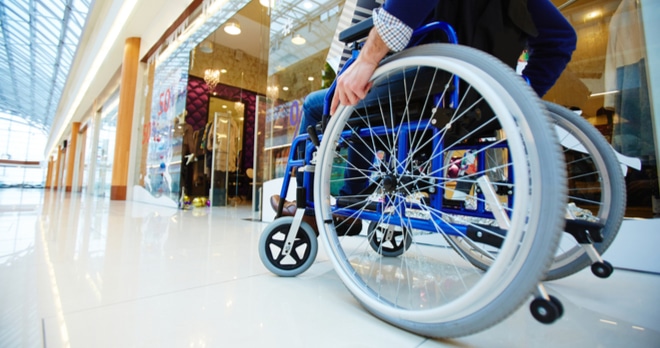Purple Tuesday – an opportunity to improve shopping experiences for everyone

Tuesday 13 November 2018 marked the first ever Purple Tuesday, a day set aside to raise awareness of the needs of disabled shoppers. It was set up by disability charity Purple, and encourages retailers to not only endorse and promote the day itself, but also stipulates that every participating retailer must make at least one long-term commitment aimed at improving the experience for their disabled customers.
Participants this year included Asda, Argos, Barclays and Marks and Spencer, and commitments could include regular ‘quiet hours’, or introducing more inclusive marketing. Not only is this good for disabled people, but evidence suggests that shops are losing out on £11.4bn of sales by not considering accessibility. Purple Tuesday is quite clearly a win-win.
As a regular manual wheelchair user myself, I can confirm that changes like these are extremely welcome. I cannot tell you the number of times I have had to find convoluted ways around shops, or become stuck in queueing systems because there simply wasn’t enough space to turn. This is assuming I’m able to enter the shop at all (according to statistics, 20% of high street shops do not provide a ramp). I sometimes try to imagine what it would be like to try to navigate my way around in a powered wheelchair, or if I were blind; sensory issues are another story altogether, in which every trip into a fluorescent-lit, noisy, colourful shop must feel like an assault.
The difficulty is that catering for ‘the disabled’ is almost as impossible as catering for, say, ‘men’: there are far too many variables in that group for one change to be meaningful. A shop may institute a ‘quiet hour’, but this does nothing to address the issues of their wheelchair-bound customers, or put in ramps, which in no way helps their customers with autism.
How Purple Tuesday can be a boon for all shoppers
Despite these concerns, Purple Tuesday is an excellent step forward for the shopping experience of disabled customers. It is supremely important to highlight the difficulties faced by disabled people in this environment, both from a financial point of view and an emotional one. If anything, I think Purple Tuesday is understated. It may not seem immediately obvious, but the needs of ‘the disabled’ are actually shared by most people.
One article I read suggested simple ways in which the experience of disabled shoppers could be improved. These included training staff to speak clearly, adjusting noise and light levels, adding more seating, ensuring all shops have ramps, and offering assistance where needed. Is it just me, or do these seem like things everyone would want? Surely these are improvements to the experience of all shoppers.
What all this effectively means is that the current system benefits no-one. Shops may consider that it is better to ram in as many products as they can, light everything to its maximum and set the tone with whatever music they see fit, but the truth is this is not more profitable; in so doing they risk losing out on a large chunk of the £249bn a year that British disabled people spend on retail and leisure.
The fundamental point is that, while it is vital to raise awareness of the needs of disabled shoppers, when it comes down to it retailers are persuaded by their bottom line. These changes will only be implemented if it can be shown that they will increase their profit margins. Purple Tuesday is a great way to show retailers that some of these changes can be made with little to no cost, and will encourage not only disabled shoppers, but others as well.
No-one is expecting retailers to action changes that they cannot afford. But, hopefully, initiatives like this will demonstrate that a common-sense approach to accessibility actually starts a process whereby the whole retail experience can be changed for the better for both retailers and consumers.